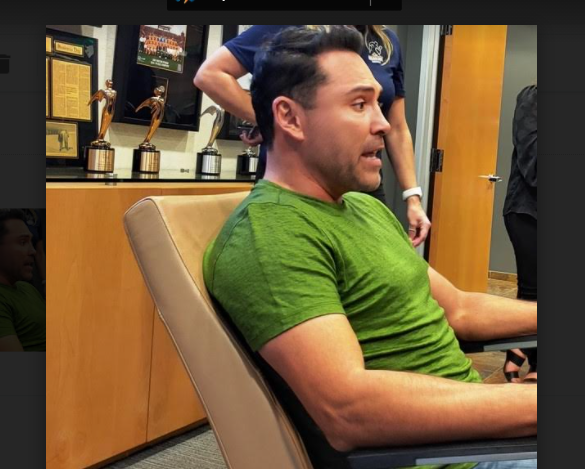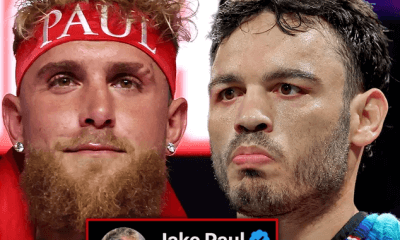Featured Articles
Avila Perspective, Chap 152: Oscar and Oscar and More

Avila Perspective, Chap 152: Oscar and Oscar and More
There’s a saying in the entertainment business “the show must go on.” That seems to apply in boxing too.
Oscar is out. Evander is in.
A return by the Golden Boy to the boxing ring was canceled when Oscar De La Hoya announced he had contracted the coronavirus. Instead of canceling the Triller Fight Club program, it was moved from the Staples Center in Los Angeles to the Seminole Hard Rock Hotel and Casino at Hollywood, Florida.
Evander Holyfield replaces De La Hoya in facing former MMA star Vitor Belfort in the main event. Other fights on the card pit MMA stars against each other in boxing gear. Former champions like Anderson Silva against Tito Ortiz will slug it out.
Florida will now be the host for this pay-per-view card on FITE.TV.
De La Hoya seemed fit and ready after spending months of training. He even hosted a small group of reporters at his Golden Boy Promotions headquarters in downtown Los Angeles. But within days he was felled by the virus and a subsequent test revealed he had the Covid-19 Delta variant though he had been vaccinated.
Ten days ago, I sat next to him as he explained his reasons for returning to the boxing ring after a 13-year absence. There were five of us reporters who shook his hand and spoke to the six-time division world champion and International Boxing Hall of Fame inductee.
“I’m a fighter,” said the East Los Angeles boss. “I miss getting hit.”
All of his reasons seemed to point to a return to boxing. Not a last-minute cancellation. Yesterday he reported he was released from the hospital. That was good news.
Maybe a return to the fight game was not meant to be for the Golden Boy. He paid his dues.
Most of my friends are unaware that for five years I did not always cover boxing. Instead, I was a metro reporter covering crime, politics and other hard news for the Los Angeles Times. In 1993 I was asked if I knew anything about boxing and East Los Angeles. Of course, I explained my former involvement in the sport and that I was raised in East L.A.
The first time I interviewed Oscar De La Hoya one-on-one he was training in a dojo in Big Bear for one of his early Las Vegas fights in the early 1990s. I forget the year. He was a huge star and skyrocketing to fame. Think Ryan Garcia times 10 and you get a semblance of his popularity and fame. In his fifth pro fight he defeated Jeff Mayweather, the uncle of Floyd Mayweather who had 22 wins and only two losses at the time. By the time he was 21 years old he was a world title-holder.
Everywhere De La Hoya appeared, a large crowd would immediately gather. I was living in Whittier when he bought a condo there. He would show up at a restaurant and throngs of people would surround the place. It was amazing how quickly the word would spread. Cell phones were still new to the general public.
I’ve covered all of his big fights except the Ike Quartey clash in February 1999. At the time I was in Miami, Florida so I watched it from a dog racetrack. The place was packed with Puerto Ricans who backed Felix Trinidad. They booed his victory but cheered when it was announced that De La Hoya would fight Tito. I attended that September 1999 fight in Las Vegas and sat next to actor Jack Nicholson.
Those were good times.
So, when he announced his retirement following the Manny Pacquiao fight in 2008, it seemed to be a perfect time. De La Hoya had accrued nearly a billion dollars. His Golden Boy Company was doing well and he was a mere 35 years old.
This past year some of the old warriors have ventured back to the prize ring to get paid or to simply feel and smell the fragrances of new boxing gloves. De La Hoya was one of them and looked eager and excited to return.
Maybe it just wasn’t meant to be.
Top Rank in Tucson
When Oscar Valdez tested positive for a banned substance by VADA it was universally assumed he was out of the picture for the main event on Friday. Sept. 10, against Robson Conceicao (16-0, 8 KOs) at Casino del Sol in Tucson, Arizona. But, “the show must go on” at the desert casino. ESPN+ will stream the Top Rank card.
Though Valdez did indeed intake a banned substance that is used as a diuretic, not an enhancement tool or drug, he was given a pass by the boxing powers. Because of that simple fact the WBC organization and the opponent Conceicao deemed that it was OK to proceed with the title fight.
Valdez (29-0, 23 KOs) returns to the ring after his most shocking knockout win over former king Miguel Berchelt last February. It was sensational and unexpected by many who thought the opposite was going to happen. One single left hook ended that fight.
Brazil’s Conceicao, a 2016 Rio Olympic gold medalist, will be challenging Valdez on his home turf. Though undefeated, he had a rough time against Luis Coria and was nearly defeated by the Southern California fighter. He wasn’t going to let this opportunity slip away and neither was Top Rank which invested time and money in the Olympian.
It’s a pretty good fight card too.
Co-headlining the fight will be WBO flyweight world titlist Junto Nakatani (21-0, 16 KOs) of Japan defending against Puerto Rico’s Angel Acosta (22-2, 21 KOs) a former light flyweight world titlist.
Nakatani has a four-fight knockout streak and Acosta a two-fight KO streak. It’s the Japanese fighter’s first match on American soil, but he has trained in Los Angeles. Don’t expect the judges to be needed for this one. Each has a rocket in his fists.
Others on the fight card include Lindolfo Delgado, Raymond Muratalla and Gabriel Flores Jr. from the Robert Garcia Boxing Academy in Riverside, Calif. Also, Puerto Rican knockout specialist Xander Zayas (9-0, 7 KOs) in a tough welterweight test against New Mexico’s Jose Luis Sanchez (11-1-1, 4 KOS) who settled for a draw after eight rounds in his last fight versus veteran Adrian Granados.
Miami Honors Yordenis Ugas
WBA welterweight world titlist Yordanis Ugas was given the key to the city by Miami’s Mayor Francis Suarez on Tuesday Sept. 7, in the office of the honorable mayor for not only successfully defending the title against eight-division world champion Manny Pacquiao, but for his words bringing attention to the people of Cuba.
Ugas was a late replacement for Errol Spence Jr. who suffered a torn retina and was forced to surrender his challenge against Filipino boxing legend “Pacman” Pacquiao.
The former Cuban refugee holds one of the versions of the title; Spence has the other. It’s confusing.
Covid KOs TGB Las Vegas Fight Card
A super bantamweight clash between WBO titlist Stephen Fulton and WBA and WBC titlist Brandon Figueroa will have to wait because Figueroa tested positive for the coronavirus.
They were headlining a TGB Promotions card at the Park Theater at Park MGM in Las Vegas in a unification clash on Sept. 18. The pandemic continues and it has struck not only the boxing world, but many other sports as well.
Fulton had a prior match canceled a year ago when he tested positive for the Covid-19 virus.
TrillerVerz
WBC and WBO super middleweight titlist Franchon Crews-Dezurn (7-1) meets IBF and WBA titlist Elin Cederroos (8-0) for the undisputed world championship on Tuesday Sept. 14, at the Seminole Hard Rock Hotel and Casino in Hollywood, Florida.
The co-main event pits Mexico’s Pablo Cano (33-7-1, 23 KOs) against Puerto Rico’s Danielito Zorrilla (15-0, 11 KOs) in a welterweight battle set for 10 rounds.
Fights to Watch
(All Times Pacific Coast Time)
Fri. ESPN+ 11:45 a.m. Tony Yoka (10-0) vs Petar Milas (15-0).
Fri. ESPN+ 2:30 p.m. Oscar Valdez (29-0) vs Robson Conceicao (16-0); Junto Nakatani (21-0) vs Angel Acosta (22-2).
Sat. FITE.TV pay-per-view 4 p.m. Evander Holyfield vs Vitor Belfort; Anderson Silva vs Tito Ortiz.
Tues. FITE.TV 3 p.m. Franchon Crews-Dezurn (7-1) vs Elin Cederroos (8-0); Pablo Cano (33-7-1) vs Danielito Zorrilla (15-0).
Check out more boxing news on video at the Boxing Channel
To comment on this story in the Fight Forum CLICK HERE
-

 Featured Articles4 weeks ago
Featured Articles4 weeks agoAvila Perspective, Chap. 330: Matchroom in New York plus the Latest on Canelo-Crawford
-

 Featured Articles3 weeks ago
Featured Articles3 weeks agoVito Mielnicki Jr Whitewashes Kamil Gardzielik Before the Home Folks in Newark
-

 Featured Articles21 hours ago
Featured Articles21 hours agoResults and Recaps from New York Where Taylor Edged Serrano Once Again
-

 Featured Articles4 weeks ago
Featured Articles4 weeks agoCatching Up with Clay Moyle Who Talks About His Massive Collection of Boxing Books
-

 Featured Articles5 days ago
Featured Articles5 days agoFrom a Sympathetic Figure to a Pariah: The Travails of Julio Cesar Chavez Jr
-

 Featured Articles3 weeks ago
Featured Articles3 weeks agoMore Medals for Hawaii’s Patricio Family at the USA Boxing Summer Festival
-

 Featured Articles1 week ago
Featured Articles1 week agoCatterall vs Eubank Ends Prematurely; Catterall Wins a Technical Decision
-

 Featured Articles4 weeks ago
Featured Articles4 weeks agoRichardson Hitchins Batters and Stops George Kambosos at Madison Square Garden




















